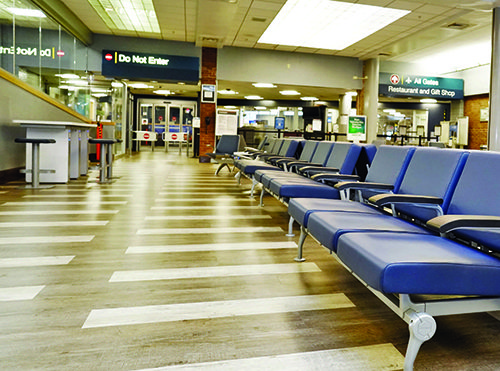How does a small airport with an aging terminal meet the needs of today’s travelers without breaking the proverbial bank? That was the bottom-line conundrum at Erie International Airport (ERI) in Pennsylvania. In total, construction lasted six months and cost $500,000. The airport completed the project in August—a timely finish given its recent rise in air traffic.
How does a small airport with an aging terminal meet the needs of today’s travelers without breaking the proverbial bank? That was the bottom-line conundrum at Erie International Airport (ERI) in Pennsylvania.
“We had a 1957 terminal building in need of an update. Or, to put it more bluntly, we had a pig in desperate need of some lipstick,” explains Airport Director Derek Martin. “Small communities generally can’t afford a completely new terminal building. Our short-term goal was to refresh the building to provide our customers with 21st century amenities and a more pleasurable travel experience—and do it as efficiently and inexpensively as possible.”
Post-9/11 Configuration
|
facts&figures Project: Budget-Oriented Terminal Update Location: Erie Int’l Airport (PA) Timeline: Feb. 2019-Aug. 2019 Approx. Cost: $500,000 Funding: Capital Improvement Fund Seating: Arconas Flooring: Congoleum Restaurant Renovation: Chardon Kitchens; Penn Glass; Watkins Construction Furniture Installation: AJ Grack Business Interiors Flooring Installation: Continental Flooring Co. Electrical: Newco Electric Plumbing/HVAC: Scobell Co. Doors: Plyer Entry Systems Sally Port: Glen Davis Sales Security: Eltech Security Systems Of Note: Airport saved money by performing some demo work itself & working directly with the flooring manufacturer. |
In total, construction lasted six months and cost $500,000. The airport completed the project in August—a timely finish given its recent rise in air traffic. In May, American Eagle added a nonstop flight to Chicago O’Hare, and two nonstops to Charlotte Douglas International. These are in addition to Delta Connection’s three daily flights to Detroit Metro and United Express’ two daily flights to O’Hare. ERI officials are also working with United to add nonstop service to Dulles International.
Previously, the terminal’s pre-9/11 layout was a constraint. But with recent updates complete, the airport is now poised for growth.
“In most airports post-9/11, travelers find it more difficult to obtain food and beverage pre-security,” Martin observes. “We had the opposite problem: Our restaurant was accessible from the landside only. Prior to the terminal update, travelers were reluctant to go through security because they had no access to food and beverages on the airside other than from vending machines. We needed to get travelers through security checkpoints where they could relax and wait for their flights. In the past, we’d have travelers waiting in the pre-security area for three different flights, which created backups when everyone tried to get through security at the last minute.”
To prevent such bottlenecks and provide service on both sides of the TSA checkpoint, ERI moved the access point to its existing restaurant from landside to airside, and secured TSA approval to install a sally port. Passengers who have cleared the checkpoint use the restaurant’s new airside entrance. Landside customers place orders on an iPad and pay via credit card following touchscreen prompts. Orders are received through a sally port system: Concessions workers on the secure side place food orders on a tray and rotate back to the customer.
 The new sally port is an important feature that helps the airport serve meeters/greeters and passengers who want to sit, relax or work landside before their flights, Martin emphasizes.
The new sally port is an important feature that helps the airport serve meeters/greeters and passengers who want to sit, relax or work landside before their flights, Martin emphasizes.
“Obtaining TSA’s permission for the sally port and changing the restaurant from landside to airside access proved to be one of our biggest challenges,” he informs. “We had to add additional doors with security mechanisms and install a rolling door divider to seal off the secure area.
“Our sally port is unique,” he adds. “I believe there are only three or four like this in airports around the country.”
Seats & Feet
Aesthetically, the 1957 interior was in sore need of a facelift. While the seating was still functional, ERI officials wanted to refresh it. In total, crews installed 242 new Arconas seats throughout the terminal, from the check-in area to baggage claim.
“The airport moved away from the rigid, linear row-by-row beam seating prevalent in the old configuration to achieve a warmer, softer feel,” says Arconas Account Manager Scott Jelliman. Cluster seating with thicker, softer cushions than most airports choose helped achieve the transformation, he explains.
 Six cluster seating groups with six seats each and curved seating that wraps around structural columns were installed in pre-security areas. InPower™ Bars and Stools provide functional stations where customers can work and charge their mobile devices.
Six cluster seating groups with six seats each and curved seating that wraps around structural columns were installed in pre-security areas. InPower™ Bars and Stools provide functional stations where customers can work and charge their mobile devices.
All told, 154 seats were installed post-security and 88 pre-security; plug-in power options were increased dramatically throughout the building.
“We tried to take into account all types of travelers: families, groups, individuals and business,” Jelliman elaborates. “While the terminal still has tandem seating, the cluster pieces and Imperial Blue vinyl seat coverings warm the terminal and offer a more collaborative, lounge-like feel while still providing excellent movement and flow through the terminal space.”
The airport also removed its original 1957 carpet and vinyl composite tile, and replaced it with 30,000 square feet of new vinyl tile.

“Replacing the flooring throughout the building was a big challenge,” Martin reports. “We had to stage construction activity around air carrier activity, working late at night or early in the morning. Some areas needed to be leveled and cured before the new flooring could be laid.”
Congoleum® Structure was selected to withstand the snowy, rainy, hot and cold Pennsylvania weather extremes, notes Congoleum National Sales Manager Jay Jacobs. “It is designed for high-traffic, commercial installations and is ideally suited for an airport environment.”
The beige and brown colors provide more visual interest than a single-color scheme and hide dirt between cleanings, he adds.
Before:
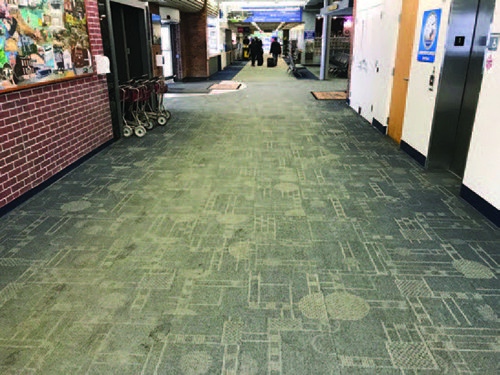
After:
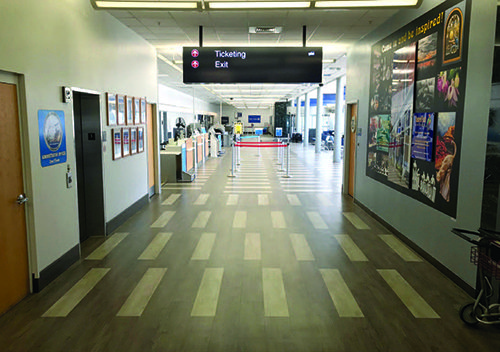
Managing Costs
The airport saved money by dealing directly with the flooring manufacturer and dispatching ERI personnel to perform some work traditionally completed by contractors.
 “As the flooring manufacturer, I can obviously control the costs of the material,” says Jacobs. “However, we were able to provide added value by allowing the airport to consider installation bids equally because the materials cost remained static. The airport was then able to evaluate installation contractors based on their expertise, timing and ability to work within the parameters established by the airport. I served as a point of contact to help articulate expectations. The project needed to be a three-legged stool between the airport, the manufacturer and the flooring contractor. Everyone had to be on the same page.”
“As the flooring manufacturer, I can obviously control the costs of the material,” says Jacobs. “However, we were able to provide added value by allowing the airport to consider installation bids equally because the materials cost remained static. The airport was then able to evaluate installation contractors based on their expertise, timing and ability to work within the parameters established by the airport. I served as a point of contact to help articulate expectations. The project needed to be a three-legged stool between the airport, the manufacturer and the flooring contractor. Everyone had to be on the same page.”
Using this approach, the airport spent about $178,000 for 30,000 square feet of new flooring—a phenomenal buy, Martin emphasizes.
Airport staff rolled up their sleeves when it came time to demolish interior walls and an old glass and brick wall in the restaurant area.
“We were able to cut costs by doing the work we could do inhouse,” Martin explains. “The project was subcontracted and piecemealed, which precluded us from having to go through an all-inclusive bidding process. It was a fluid process and we had to remain flexible with our design.”
Before:
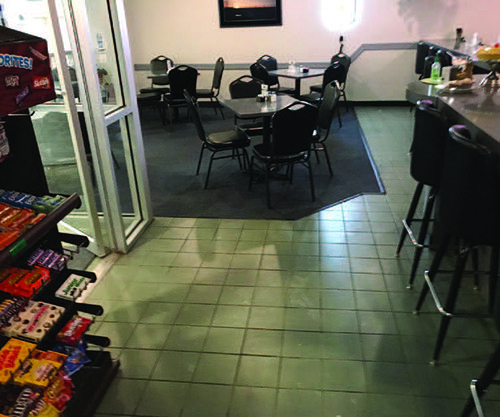
After:
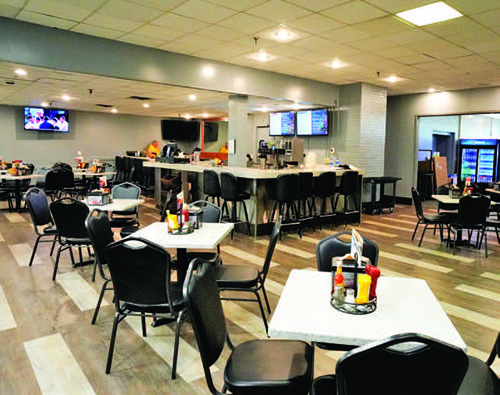
More Improvements Planned
While the updated terminal serves ERI’s current needs, airport management has an eye on future growth and the new projects it will require.
Currently, the terminal has one baggage claim, which is problematic given the airport’s desire to grow air service in 2020. “We’ll be looking to knock out a wall and expand the terminal by 4,000 square feet to accommodate an additional baggage belt,” says Martin. “We’d also like to realign the TSA baggage screening so that it takes up a smaller footprint and gives air carriers a seamless single location to pick up bags behind the screening area wall.”
Outside the terminal, ERI plans to relocate and consolidate car rentals to free up space in front of the building.
Preparing for these projects, Martin reflects on the outcome of recent terminal enhancements: “Our customers’ travel experience has been enhanced with top-of-the-line amenities that might be offered at major airports around the country. And we did it on a budget.”

